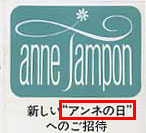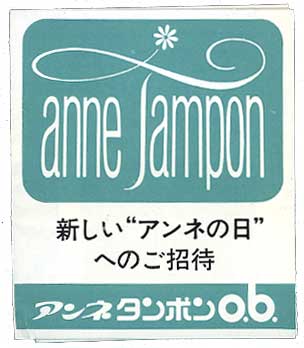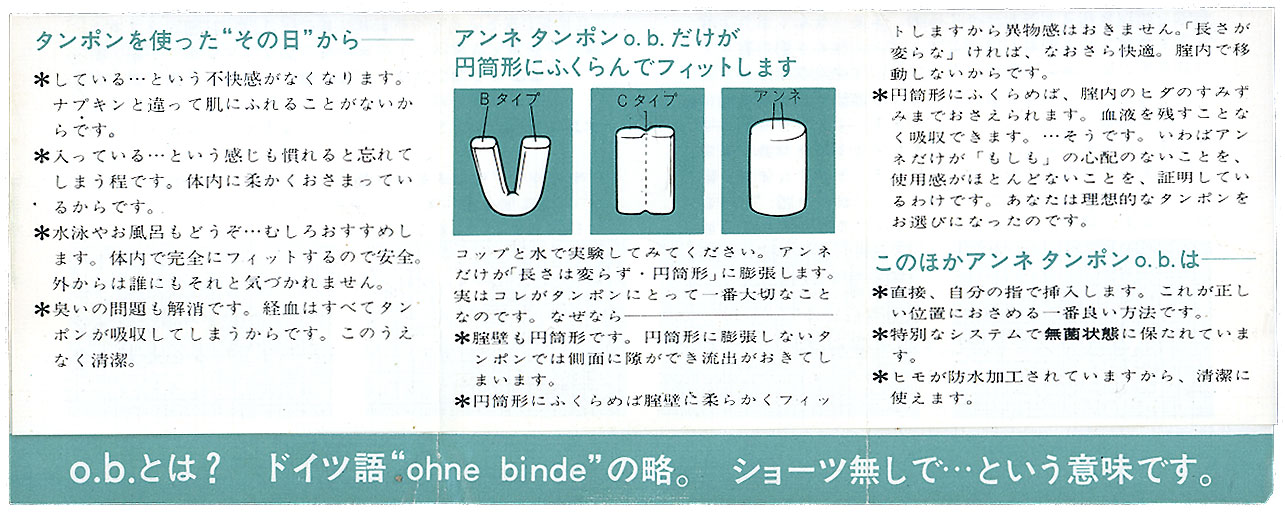o.b. ads,
booklets & actual tampons: German (1970s) - German (1972) nude
woman on bed - German
nude (1970s) - French
(1989) - folder,
Germany, early 1950s (tells
what o.b. means!) - Dutch, two ads from
1959 giving THEIR take on what o.b. means,
which was wrong - Dutch ads, 1962, 1967 - Belgian ad with
beach & bathing suits, 1980s? - American
ad showing Judith
Esser, designer of the o.b. tampon,
August, 1984 - o.b. puberty
booklets (excerpts): German, Dutch (2004) -
o.b. actual tampons:
Switzerland (o.b.é.),
1970
More o.b. booklets:
[Die] Menstruation (excerpts, 1977,
o.b. tampons, Germany) Photographer David
Hamilton contributed many photographs to
this explicit and beautiful booklet. By the
way, "Die" in the title means "the," not to
lose life.
Volwassen worden
("Growing up," the Netherlands, excerpts, 2004,
o.b. tampons)
Your Personal Guide to
Menstruation and Tampon Usage (complete booklet,
U.S.A., 1988, o.b. tampons)
Booklets
menstrual hygiene companies made for girls,
women and teachers - patent
medicine - a list
of books and articles about menstruation
See early tampons
and a list of tampons
on this site - at least the ones I've
cataloged.


|

Anne
non-applicator menstrual
tampons with finger cots, box of 10
(1968), Japan, from o.b.
tampon
I thank
the former Tambrands (history) for the
donation!
|
Below:
Small overviews
of the two sides of the instructions,
which start below; the
sheet measures
5 7/8 x 4 1/4" (14.7 x 10.8 cm).
BUT FIRST:
The Anne
of the tampon name
comes from "Anne's
day" - a
Japanese euphemism for
menstruation - and lies
right below
the big green ANNE
TAMPON box below and at
right.

The three
characters at the left
phonetically spell ANNE
(actually ANN-NE, two
syllables in Japanese
and Dutch but not in
American English) in the
katakana script that the
Japanese use for foreign
words. The next one is
NO, which means
possession ("of," for
example). The far right
character means DAY. So,
Day of Anne or Anne's
day.
Anne is none other
than ANNE
FRANK, who
wrote about her period
in her famous diary
while hiding in
Amsterdam during World
War II. The Nazi's found
her (and others) and
hauled her off to a
concentration camp,
where she died.
The Dutch contributor
of many items for this
site writes that Japanese
teenage girls admired
her for writing so
openly about her "sweet
secret."
(The book Sweet
Secrets:
Stories of
Menstruation is by
the contributor of much
information to
this site, Kathleen
O'Grady.) Apparently a
Japanese menstrual pad
also bore her name. I
don't think Ms. Frank
would have been ashamed
of that.
|

I thank the Dutch
father of four girls for
pointing these facts out
and for reminding me
that years ago I put "Anne's
day" on the list of Japanese euphemisms that a
professional
translator of Japanese
sent and then
forgot about it.
And in March 2010 I
attended a lecture at
the National Gallery of
Art in Washington by the
director of England's
National Gallery of Art
on Spanish religious
sculpture and painting
(1600-1700) that
mentioned that Jesuit
priests in Japan
in the 17th century
brought back Japanese
sculpture that
influenced Spanish
religious carvings. The
lecturer, Dr. Nicholas
Penny, said the
Jesuits almost
exchanged their
clothing for kimonos!
Small world.
|
|
|
|
Below:
The instructions present this face
when you pull the sheet from the
opened box.
|
 |
Below: Unfold
the instructions twice
and you see this three-panel view.
The green
band at the bottom is
actually the lowest part of the
other side. It
explains that o.b. is the
abbreviation for the German
"ohne Binde," "without a
menstrual pad."
The librarian at Johnson &
Johnson, which had bought the
tampon company
in the 1970s, didn't know what
o.b. meant; I asked her
in the mid 1990s. Neither
did this Dutch
ad
although this is might be
intentional ignorance for
marketing.
But an earlier
o.b. pamphlet revealed all.
|
 |
NEXT | box -
instructions p.2
- tampon
o.b. ads,
booklets & actual tampons: German
(1970s) - German
(1972) nude woman on bed - German nude
(1970s) - French
(1989) - folder,
Germany, early 1950s (tells what o.b.
means!) - Dutch,
two ads from 1959 giving THEIR take on
what o.b. means, which was wrong - [Die]
Menstruation (excerpts,
1977, o.b. tampons, Germany)
Photographer David Hamilton
contributed many photographs to
this explicit and beautiful
booklet.
So many BOOKLETS
- So many TAMPONS
|
|
© 2010 Harry Finley. It is illegal to
reproduce or distribute any of the work on
this Web site in any manner or medium
without written permission of the author.
Please report suspected violations to hfinley@mum.org
|